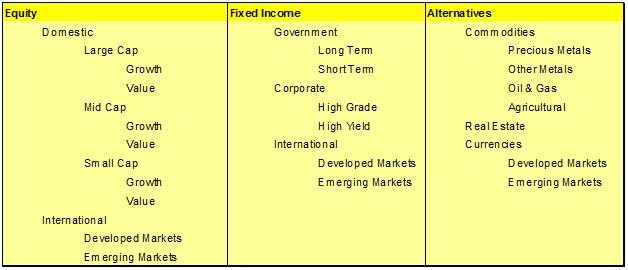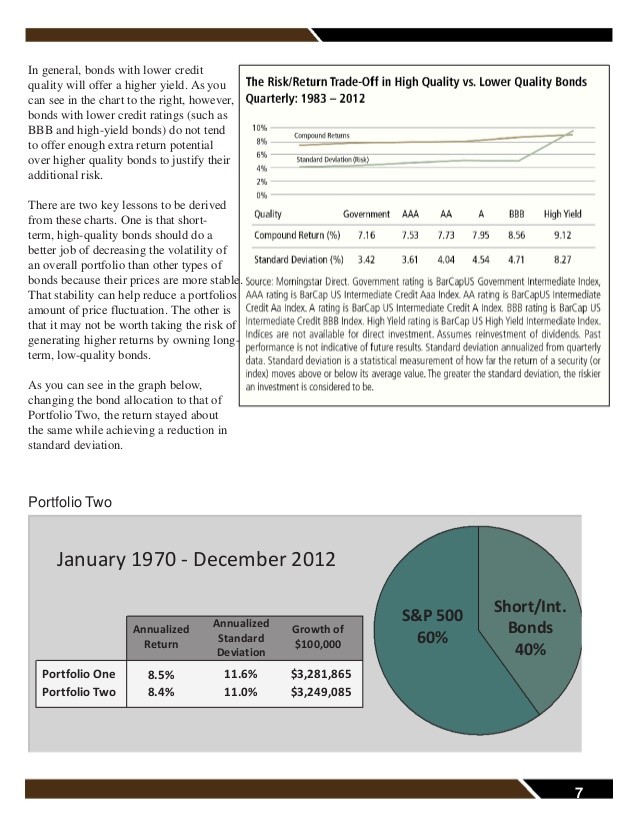Building a Diversified Bond Portfolio
Post on: 16 Март, 2015 No Comment

Everyone has heard the saying you need to diversify. You hear about it for your portfolio as a whole diversify in stocks and bonds. There are even some handy simple calculations to figure out how to do it (subtract you age from 100, and that is how much you should invest in stocks). You also hear about diversifying your stocks. Own different sectors, or have an index fund that owns the entire market. What you dont always hear about is diversifying bonds.
The Different Types of Bonds
There are many different categories or types of bonds, just like there are various sectors for stocks. Here are the main types of bonds:
- US Treasury Bonds (Debt issued directly by the US Government)
- Short Term: T-Bills (Not technically a bond, but pretty much the same thing) Maturing in less than 1 year
- Medium Term: Treasury Notes Maturing in 1-10 years
- Long Term: Treasury Bonds Maturing in 10+ years
- Inflation Protected
Remember What a Bond Is
When investing in bonds, it is important to remember what a bond is. You are loaning money to the entity you are buying the bond from. For a US Treasury Bond, you are loaning money to the United States Government. For a corporate bond, you are loaning money to that company.
The Risks Involved in Investing in Bonds
As with any investment, there are risks involved that should be considered. Many people consider US Treasury Bonds to be risk-free, but even investing in them can pose a risk to your portfolio. Here are some common bond investing risks:
- Credit Risk: Credit risk is the risk that the issuer of the bond is unable to meets its financial obligations, such as make scheduled interest payments or pay off the obligation at maturity. Credit risk is evaluated by several outside companies, such as S&P and Moodys, and they issue debt rating from Aaa or AAA to D for those in default. The higher the grade, the less likely the issuer is going to default. Some municipal bonds are backed by insurance policies to guarantee repayment of principal in the event of default. You can read about potential credit risk to the United States in my article about Not Raising the Debt Ceiling .
- Interest Rate Risk. Interest rate risk is the risk that the yields of new bonds issued in the market are higher than your current bond, making your bond less valuable to new issuances. The rate of this occurring is very high right now since interest rates are near 0%. As interest rates rise, which will happen sometime, lower yielding bonds will lose value compared to the new bonds at the higher rates.
- Call Risk. Many corporate and municipal bonds have a call risk, which means that the issuer can repay all or a portion of the bond prior to maturity. The investors capital will be returned with a premium in exchange for retiring the debt. It is a risk because your income stream ends earlier that you were planning on it.
Why and How To Build a Diversified Bond Portfolio
Given all the different types of bonds, and the risks inherit in each, you can mitigate some of the risk by diversifying your bond portfolio. Just like investing in stocks, when one class of debt goes down, others usually rise. Also, with different debts maturing at different times, you can hedge against some of the risks associated with interest rates. Finally, with a large basket of debt types, you hedge against one debt defaulting. If youre going to invest in bonds using bond funds, it is important that you understand the bond funds performance as well.
It is also important to remember that as interest rates rise, bond prices fall, and the opposite occurs. Since we are currently at an all-time low of interest rates, we are also at an all-time high of bond prices (especially US Treasuries). So, it can be insinuated that US Treasury prices will fall over the short to medium term. If your portfolio was invested 100% in US Treasuries, your portfolio would decline in value. However, if you were diversified into other debt types, the impact of this would be minimal.
To build a diversified bond portfolio, you need to consider both the maturity of the debt as well as the type of debt. Using my original classes above, here are some things to consider:
Risk: The least riskiest investments above are US Treasury Debt. I would follow this closely with Developed European Debt, then municipal general obligation bonds, and high grade corporate bonds (there are a few AAA companies out there). The riskiest investments in bonds Bank Loans, low grade corporate bonds, and municipal revenue obligation bonds. However, just like in stocks, the riskier assets pay a risk-premium to hold them, so you do get a higher return than by holding US Treasury Debt.
Interest Rates: With interest rates being so low, you want to focus on bonds with short maturities. That way, if rates do rise, you are not holding a debt that will drop in value. You can easily roll your money into higher yielding bonds quickly if the maturity is shorter. T-Bills, some corporate bonds, and bank loans all fall into this category.
With those two key ideas in mind, we can build a portfolio of bonds. Like any passive investor, we want to build a portfolio for the long run. This means finding low cost index funds that meet the bond criteria we were looking for. There are many, but here are some of my favorite picks and how I would diversify my portfolio:
Here are some top picks to fill in each area of my bond portfolio:

- Short Term US
- Vanguard Short Term Treasury Investor (VFISX)
With these funds, you can quickly and effectively build a diversified bond portfolio. As a final note, it is important to remember what vehicle you are putting these investments into. Since municipal bonds are already usually tax deferred, you dont need them to be in a tax deferred account such as an IRA. However, some bonds you would want in an IRA because they pay interest monthly.














